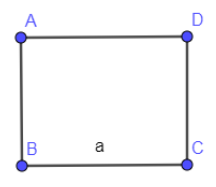Answer
396k+ views
Hint: Let us assume that the side of the square is “a'' then the area of the square is $''{{a}^{2}}''$. Let us assume the area of the square to be “A” then $A={{a}^{2}}$. Now, taking log on both the sides and then differentiating both the sides and we get this area equation as $\dfrac{\Delta A}{A}=2\dfrac{\Delta a}{a}$, now multiplying 100 on both the sides so that the left-hand side will become percentage change in A and right-hand side apart from 2 will become percentage change in “a”. Then substitute the percentage increase in the side of a square as 4 and from the percentage change equation find the percentage increase in area.
Complete step-by-step solution:
Let us assume that the side of the square is “a”.
And we know that area of the square is equal to $''{{a}^{2}}''$.
In the below diagram, we have drawn a square ABCD with the length of the side as “a”.

Let us assume that area of the square is “A” then we can write the equation of the area of the square as:
$A={{a}^{2}}$
Taking log on both the sides we get,
$\log A=2\log a$
Now, differentiating both the sides we get,
$\dfrac{\Delta A}{A}=2\dfrac{\Delta a}{a}$
Multiplying 100 on both the sides so that the area and its side will be in percentage relation with each other.
$\dfrac{\Delta A}{A}\times 100=2\dfrac{\Delta a}{a}\times 100$
It is given that percentage increase in the side of the square is $4\%$ which means the ratio of change in the side with the original length of the side and multiply by 100 is $4\%$ so substituting $\dfrac{\Delta a}{a}\times 100$ as 4 in the above equation we get,
$\dfrac{\Delta A}{A}\times 100=2\left( 4 \right)$
Multiplying the right-hand side we get,
$\dfrac{\Delta A}{A}\times 100=8$
The left-hand side of the above equation is the percentage increase in area.
Hence, the percentage increase in area is $8\%$.
Note: There is an information or trick that we can extract from this question and use it in questions which are of this question type whenever you have given the expression in which the terms are in power of square, cube or some number and we are asked to find the percentage increase or decrease then use the following method:
Let us assume that “P” has a relation with x and y as follows:
$P={{x}^{m}}{{y}^{n}}$
First of all take log on both the sides and then differentiate we get,
$\begin{align}
& \log P=m\log x+n\log y \\
& \Rightarrow \dfrac{\Delta P}{P}=m\dfrac{\Delta x}{x}+n\dfrac{\Delta y}{y} \\
\end{align}$
Multiplying 100 on both the sides we get,
$\dfrac{\Delta P}{P}\times 100=m\left( \dfrac{\Delta x}{x}\times 100 \right)+n\left( \dfrac{\Delta y}{y}\times 100 \right)$
The above relation is in percentage change in P, x and y.
Complete step-by-step solution:
Let us assume that the side of the square is “a”.
And we know that area of the square is equal to $''{{a}^{2}}''$.
In the below diagram, we have drawn a square ABCD with the length of the side as “a”.

Let us assume that area of the square is “A” then we can write the equation of the area of the square as:
$A={{a}^{2}}$
Taking log on both the sides we get,
$\log A=2\log a$
Now, differentiating both the sides we get,
$\dfrac{\Delta A}{A}=2\dfrac{\Delta a}{a}$
Multiplying 100 on both the sides so that the area and its side will be in percentage relation with each other.
$\dfrac{\Delta A}{A}\times 100=2\dfrac{\Delta a}{a}\times 100$
It is given that percentage increase in the side of the square is $4\%$ which means the ratio of change in the side with the original length of the side and multiply by 100 is $4\%$ so substituting $\dfrac{\Delta a}{a}\times 100$ as 4 in the above equation we get,
$\dfrac{\Delta A}{A}\times 100=2\left( 4 \right)$
Multiplying the right-hand side we get,
$\dfrac{\Delta A}{A}\times 100=8$
The left-hand side of the above equation is the percentage increase in area.
Hence, the percentage increase in area is $8\%$.
Note: There is an information or trick that we can extract from this question and use it in questions which are of this question type whenever you have given the expression in which the terms are in power of square, cube or some number and we are asked to find the percentage increase or decrease then use the following method:
Let us assume that “P” has a relation with x and y as follows:
$P={{x}^{m}}{{y}^{n}}$
First of all take log on both the sides and then differentiate we get,
$\begin{align}
& \log P=m\log x+n\log y \\
& \Rightarrow \dfrac{\Delta P}{P}=m\dfrac{\Delta x}{x}+n\dfrac{\Delta y}{y} \\
\end{align}$
Multiplying 100 on both the sides we get,
$\dfrac{\Delta P}{P}\times 100=m\left( \dfrac{\Delta x}{x}\times 100 \right)+n\left( \dfrac{\Delta y}{y}\times 100 \right)$
The above relation is in percentage change in P, x and y.
Recently Updated Pages
The branch of science which deals with nature and natural class 10 physics CBSE

The Equation xxx + 2 is Satisfied when x is Equal to Class 10 Maths

Define absolute refractive index of a medium

Find out what do the algal bloom and redtides sign class 10 biology CBSE

Prove that the function fleft x right xn is continuous class 12 maths CBSE

Find the values of other five trigonometric functions class 10 maths CBSE

Trending doubts
State the differences between manure and fertilize class 8 biology CBSE

Why are xylem and phloem called complex tissues aBoth class 11 biology CBSE

Difference between Prokaryotic cell and Eukaryotic class 11 biology CBSE

Difference Between Plant Cell and Animal Cell

What would happen if plasma membrane ruptures or breaks class 11 biology CBSE

Give 10 examples for herbs , shrubs , climbers , creepers

What precautions do you take while observing the nucleus class 11 biology CBSE

What would happen to the life of a cell if there was class 11 biology CBSE

Change the following sentences into negative and interrogative class 10 english CBSE



